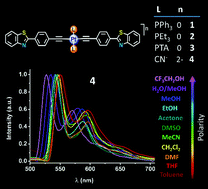Phosphorescent platinum(ii) alkynyls end-capped with benzothiazole units†
Abstract
Symmetric trans-bis(alkynyl)bis(phosphine) PtII complexes based on the 2-phenylbenzothiazole (pbt) unit [trans-Pt(C![[triple bond, length as m-dash]](https://www.rsc.org/images/entities/char_e002.gif) C-pbt)2L2] [L = PPh31, PEt32, 1,3,5-triaza-7-phosphaadamantane (PTA) 3] and the mixed alkynyl–cyanide anionic complex (NBu4)2[trans-Pt(C
C-pbt)2L2] [L = PPh31, PEt32, 1,3,5-triaza-7-phosphaadamantane (PTA) 3] and the mixed alkynyl–cyanide anionic complex (NBu4)2[trans-Pt(C![[triple bond, length as m-dash]](https://www.rsc.org/images/entities/char_e002.gif) C-pbt)2(CN)2] (4) were synthesized. The complexes have been fully characterized including X-ray crystallography for 2 and 4. All complexes display long-lived emission with moderate quantum yields (ϕ 6.8–22.6%) in doped PMMA films at 298 K and complex 4 is also emissive in DMSO fluid and in rigid media (solid, glass at 77 K). Complex 4 displays a negative solvatochromic behavior. Absorption and emission energies have been analyzed by means of linear solvation energy based on Kamlet–Taft solvatochromism parameters and the Gutmann's acceptor numbers. The study indicates that solvatochromism is due to the contribution of solvent-to-cyanide hydrogen bonding and increased solvent dipolarity–polarizability. TD and TD-DFT calculations were performed on the ground and excited states of two different conformers of 2 and 4 to provide insight into the structural, electronic and optical properties of these systems.
C-pbt)2(CN)2] (4) were synthesized. The complexes have been fully characterized including X-ray crystallography for 2 and 4. All complexes display long-lived emission with moderate quantum yields (ϕ 6.8–22.6%) in doped PMMA films at 298 K and complex 4 is also emissive in DMSO fluid and in rigid media (solid, glass at 77 K). Complex 4 displays a negative solvatochromic behavior. Absorption and emission energies have been analyzed by means of linear solvation energy based on Kamlet–Taft solvatochromism parameters and the Gutmann's acceptor numbers. The study indicates that solvatochromism is due to the contribution of solvent-to-cyanide hydrogen bonding and increased solvent dipolarity–polarizability. TD and TD-DFT calculations were performed on the ground and excited states of two different conformers of 2 and 4 to provide insight into the structural, electronic and optical properties of these systems.



 Please wait while we load your content...
Please wait while we load your content...